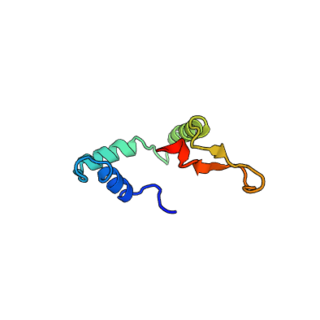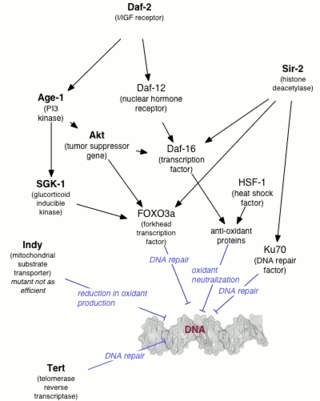
The insulin-like growth factors (IGFs) are proteins with high sequence similarity to insulin. IGFs are part of a complex system that cells use to communicate with their physiologic environment. This complex system consists of two cell-surface receptors, two ligands, a family of seven high-affinity IGF-binding proteins, as well as associated IGFBP degrading enzymes, referred to collectively as proteases.

Caenorhabditis elegans is a free-living transparent nematode about 1 mm in length that lives in temperate soil environments. It is the type species of its genus. The name is a blend of the Greek caeno- (recent), rhabditis (rod-like) and Latin elegans (elegant). In 1900, Maupas initially named it Rhabditides elegans. Osche placed it in the subgenus Caenorhabditis in 1952, and in 1955, Dougherty raised Caenorhabditis to the status of genus.
The DAF-2 gene encodes for the insulin-like growth factor 1 (IGF-1) receptor in the worm Caenorhabditis elegans. DAF-2 is part of the first metabolic pathway discovered to regulate the rate of aging. DAF-2 is also known to regulate reproductive development, resistance to oxidative stress, thermotolerance, resistance to hypoxia, and resistance to bacterial pathogens. Mutations in DAF-2 and also Age-1 have been shown by Cynthia Kenyon to double the lifespan of the worms. In a 2007 episode of WNYC’s Radiolab, Kenyon called DAF-2 "the grim reaper gene.”

Haemonchus contortus, also known as the barber's pole worm, is a very common parasite and one of the most pathogenic nematodes of ruminants. Adult worms attach to abomasal mucosa and feed on the blood. This parasite is responsible for anemia, oedema, and death of infected sheep and goats, mainly during summer in warm, humid climates.
Dauer describes an alternative developmental stage of nematode worms, particularly rhabditids including Caenorhabditis elegans, whereby the larva goes into a type of stasis and can survive harsh conditions. Since the entrance of the dauer stage is dependent on environmental cues, it represents a classic and well studied example of polyphenism. The dauer state is given other names in the various types of nematodes such as ‘diapause’ or ‘hypobiosis’, but since the C. elegans nematode has become the most studied nematode, the term ‘dauer stage’ or 'dauer larvae' is becoming universally recognised when referring to this state in other free-living nematodes. The dauer stage is also considered to be equivalent to the infective stage of parasitic nematode larvae.

Major sperm protein (MSP) is a nematode specific small protein of 126 amino acids with a molecular weight of 14 kDa. It is the key player in the motility machinery of nematodes that propels the crawling movement/motility of nematode sperm. It is the most abundant protein present in nematode sperm, comprising 15% of the total protein and more than 40% of the soluble protein. MSP is exclusively synthesized in spermatocytes of the nematodes. The MSP has two main functions in the reproduction of the helminthes: i) as cytosolic component it is responsible for the crawling movement of the mature sperm, and ii) once released, it acts as hormone on the female germ cells, where it triggers oocyte maturation and stimulates the oviduct wall to contract to bring the oocytes into position for fertilization. MSP has first been identified in Caenorhabditis elegans.

Emodepside is an anthelmintic drug that is effective against a number of gastrointestinal nematodes, is licensed for use in cats and belongs to the class of drugs known as the octadepsipeptides, a relatively new class of anthelmintic, which are suspected to achieve their anti-parasitic effect by a novel mechanism of action due to their ability to kill nematodes resistant to other anthelmintics.

In molecular biology lin-4 is a microRNA (miRNA) that was identified from a study of developmental timing in the nematode Caenorhabditis elegans. It was the first to be discovered of the miRNAs, a class of non-coding RNAs involved in gene regulation. miRNAs are transcribed as ~70 nucleotide precursors and subsequently processed by the Dicer enzyme to give a 21 nucleotide product. The extents of the hairpin precursors are not generally known and are estimated based on hairpin prediction. The products are thought to have regulatory roles through complete or partial complementarity to mRNA. The lin-4 gene has been found to lie within a 4.11kb intron of a separate host gene.

DAF-16 is the sole ortholog of the FOXO family of transcription factors in the nematode Caenorhabditis elegans. It is responsible for activating genes involved in longevity, lipogenesis, heat shock survival and oxidative stress responses. It also protects C.elegans during food deprivation, causing it to transform into a hibernation - like state, known as a Dauer. DAF-16 is notable for being the primary transcription factor required for the profound lifespan extension observed upon mutation of the insulin-like receptor DAF-2. The gene has played a large role in research into longevity and the insulin signalling pathway as it is located in C. elegans, a successful ageing model organism.
In molecular biology, the EMI domain, first named after its presence in proteins of the EMILIN family, is a small cysteine-rich protein domain of around 75 amino acids. The EMI domain is most often found at the N terminus of metazoan extracellular proteins that are forming or are compatible with multimer formation. It is found in association with other domains, such as C1q, laminin-type EGF-like, collagen-like, FN3, WAP, ZP or FAS1. It has been suggested that the EMI domain could be a protein-protein interaction module, as the EMI domain of EMILIN-1 was found to interact with the C1q domain of EMILIN-2.

Genetics of aging is generally concerned with life extension associated with genetic alterations, rather than with accelerated aging diseases leading to reduction in lifespan.
UNC is a set of proteins first identified through a set of screening tests in Caenorhabditis elegans, looking for roundworms with movement problems. Worms with which were un-coordinated were analysed in order to identify the genetic defect. Such proteins include UNC-5, a receptor for UNC-6 which is one of the netrins. Netrins are a class of proteins involved in axon guidance. UNC-5 uses repulsion (genetics) to direct axons while the other netrin receptor UNC-40 attracts axons to the source of netrin production.
WormBase is an online biological database about the biology and genome of the nematode model organism Caenorhabditis elegans and contains information about other related nematodes. WormBase is used by the C. elegans research community both as an information resource and as a place to publish and distribute their results. The database is regularly updated with new versions being released every two months. WormBase is one of the organizations participating in the Generic Model Organism Database (GMOD) project.

Caenorhabditis elegans- microbe interactions are defined as any interaction that encompasses the association with microbes that temporarily or permanently live in or on the nematode C. elegans. The microbes can engage in a commensal, mutualistic or pathogenic interaction with the host. These include bacterial, viral, unicellular eukaryotic, and fungal interactions. In nature C. elegans harbours a diverse set of microbes. In contrast, C. elegans strains that are cultivated in laboratories for research purposes have lost the natural associated microbial communities and are commonly maintained on a single bacterial strain, Escherichia coli OP50. However, E. coli OP50 does not allow for reverse genetic screens because RNAi libraries have only been generated in strain HT115. This limits the ability to study bacterial effects on host phenotypes. The host microbe interactions of C. elegans are closely studied because of their orthologs in humans. Therefore, the better we understand the host interactions of C. elegans the better we can understand the host interactions within the human body.

Cooperia oncophora is one of the most common intestinal parasitic nematodes in cattle in temperate regions. Infections with C. oncophora may result in mild clinical symptoms, but can lead to weight loss and damage of the small intestine, especially when co-infections with other nematodes such as O. ostertagi occur. Infections are usually treated with broad-spectrum anthelmintics such as benzimidazole, but resistance to these drugs has developed in the last decades and is now very common. C. oncophora has a direct life cycle. Infective larvae are ingested by the host. The larvae grow to adults, which reproduce in the small intestines. Eggs are shed onto the pasture with the faeces, which leads to new infections. Co-infections with other gastro-intestinal nematodes such as O. ostertagi and H. contortus are common.

Cry6Aa is a toxic crystal protein generated by the bacterial family Bacillus thuringiensis during sporulation. This protein is a member of the alpha pore forming toxins family, which gives it insecticidal qualities advantageous in agricultural pest control. Each Cry protein has some level of target specificity; Cry6Aa has specific toxic action against coleopteran insects and nematodes. The corresponding B. thuringiensis gene, cry6aa, is located on bacterial plasmids. Along with several other Cry protein genes, cry6aa can be genetically recombined in Bt corn and Bt cotton so the plants produce specific toxins. Insects are developing resistance to the most commonly inserted proteins like Cry1Ac. Since Cry6Aa proteins function differently than other Cry proteins, they are combined with other proteins to decrease the development of pest resistance. Recent studies suggest this protein functions better in combination with other virulence factors such as other Cry proteins and metalloproteinases.>
Worm bagging is a form of vivipary observed in nematodes, namely Caenorhabditis elegans. The process is characterized by eggs hatching within the parent and the larvae proceeding to consume and emerge from the parent.
"Chryseobacterium nematophagum" is a Gram-negative, aerobic and rod-shaped bacteria in the genus Chryseobacterium, which was first isolated from Caenorhabditis briggsae nematodes in rotting apples in France. It exhibits gliding motility. After ingestion by a nematode, they attack it from within, breaking down its extracellular matrices and killing it. In laboratory tests C. nematophagum infected and killed a wide variety of nematodes, including the model organism Caenorhabditis elegans, and the vertebrate parasites Ancylostoma caninum, Cooperia curtecei, Cooperia oncophera, Haemonchus contortus, Nippostrongylus brasiliensis, Ostertagia ostertagi, Parastrongyloides trichosura and Trichostrongylus vitrinus.
The DAF-8 nematode gene encoding a R-SMAD protein of TGF-beta signaling pathway, which was originally found in model organism Caenorhabditis elegans. When the TGF-β ligand daf-7 binds to the TGF-β receptors daf-1/daf-4 on the surface of nematode cell, daf-8 will be phosphorylated and forms a heterodimer with daf-14, then enter to the nucleus to inhibit transcription regulated by daf-3/daf-5.
Cytochrome P450, family 23, also known as CYP23, is a nematoda cytochrome P450 monooxygenase family. The first gene identified in this family is the CYP23A1 from the Caenorhabditis elegans, is a homolog of the human gene CYP7B1.













